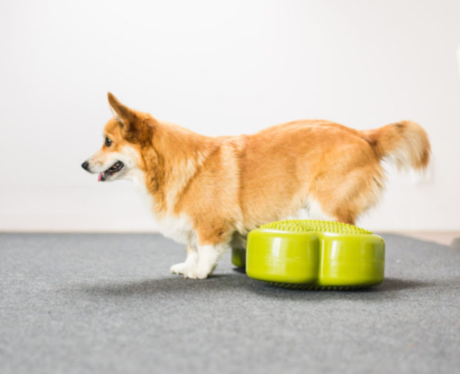
The prognosis for canine patients with degenerative myelopathy (DM) is often grim. However, recent findings demonstrate that individual exercise programs combined with photobiomodulation can improve quality of life and longevity.
The mention or diagnosis of degenerative myelopathy (DM) often takes the wind out of many practitioners’ sails. Historically, dogs diagnosed with DM – formally or through process of elimination – do not have an optimistic future. A typical course of action involves palliative care, preparation for assistive devices, and euthanasia planning. Many owners will quickly peruse the internet and find information on ‘cures’ or suggestions – though many of these findings offer little to no hope.
New studies offer promising results
Despite the prognosis that typically accompanies a DM diagnosis, there are many recent advances in how we care for dogs with this disease. For instance, a study by Kathmann et al. demonstrated an increase in life expectancy with the introduction of an intensive therapeutic exercise program.i Preliminary research has demonstrated an even longer improvement in life expectancy and quality of life with the introduction of photobiomodulation (PBM) in conjunction with an individual therapeutic exercise program.
The most recent study examined the impact of intensive PBM and an exercise program compared to an exercise program with less intense PBM. It included twice weekly in-clinic rehabilitation therapy, photobiomodulation, range-of-motion exercises and stretching, core exercises, and an at-home exercise program. In addition, the owners were invited to maintain a log of the dog’s daily activities and function. Supportive care recommendations were made and encouraged as the dog needed them. They included the use of harnesses, walking supports, protective boots and socks.
Applying the findings
I encourage owners to come in twice a week with their dog because the prospect of additional clinical visits favors the dog’s potential outcome. Flexible clinic hours and the ability to day board assists in seeing the dogs twice a week.
PBM
I begin the treatment with PBM (before exercise), but if the schedule does not permit, we can perform the PBM last during the in-house treatment session. I prefer a Class IV laser unit to offer delivery of sufficient energy in an efficient timeframe and sufficient irradiance to achieve dosing deep to the spinal cord. The treatment area includes the thoracic region from T6 to T13, and then the lumbar region. My preference is a contact method so the dog benefits from the massage and pressure action of the unit and minimizing reflection of light off the skin. In the study demonstrating the improvement, a 980nm wavelength was used, emitting 6 to 12 Watts (increased for larger dogs. i.e., German Shepherds) and an energy density of 14 to 21 j/cm2. A continuously moving grid is utilized at a speed of 1 to 3 inches per second. The total treatment time may be between 25-30 minutes – lengthy, but incredibly beneficial.
Stretching
The dog should be comfortable and, if possible, be encouraged to stretch throughout the session. Dogs with DM need a great deal of hip extension stretching due to the positioning of their hips and lumbar spine. Shoulder extension is another area that needs to be addressed secondary to the increase in weightbearing on the forelimb complex.
Exercise
Core exercises are a principal component for successful rehabilitation. Begin with standing exercises and gentle weight shifting. The weight shifting should be firm enough to encourage a weight shift, but not so firm as to throw the dog off balance. Ideally, I like to see a slow weight shift and weight bearing on the limbs. I suggest working medial to lateral, cranial to caudal, and then diagonally. This should be performed until fatigue, with a focus on quality not quantity.
One dog may be able to perform this for a total of one minute, while others may be able to perform it for up to five minutes. The progression from here will be on safe and phthalate-free surfaces. This will add increased balance, proprioception, body awareness and core strength. Since DM will result in continued loss of the postural muscles and respiratory muscles, it is imperative to prepare the dog. The added and continued strength of the core musculature may result in decreased pulmonary complications, and improved strength throughout the body whether they are ambulatory or in any assistive device.
Additional therapeutic exercises such as negotiating over unstable surfaces, walking over cavalettis, and modified walking are also recommended. An underwater treadmill will allow an increase in endurance, an improvement in cardiac and pulmonary strength, and overall muscle strength. The water height may be adjusted to increase or decrease weightbearing, and the properties of water will assist with buoyancy. The action of walking in water will also allow for active hip extension. I prefer underwater treadmill walking over swimming since it activates more of the shoulder and hip extensors and remains a weight-bearing exercise.
Setting realistic goals and expectations
The establishment of short- and long-term goals will be important to increase the intensity of exercises. With PBM, range-of-motion, core exercises, therapeutic exercises, the underwater treadmill and a home exercise program, it is not uncommon to see an improvement initially, a plateau and a gradual decline. The short-term goals should be adjusted every two to three weeks.
While there is no ‘secret’ formula to maintain a full life expectancy for dogs with DM, there is hope in prolonging the length and quality of life. The combination of intense photobiomodulation, active exercises, underwater treadmill, range-of-motion, and appropriate nutrition can improve the longevity and quality of life with dogs with DM.
Author: Debbie Gross Torraca, DPT, MSPT, Board-Certified Orthopedic Clinical Specialist Emeritus, CCRP
Link: https://ivcjournal.com/articles/
Need Debbie Gross Torraca’s help for your pet at home? Contact act her here for a virtual consult and get the help you need without ever leaving home.


